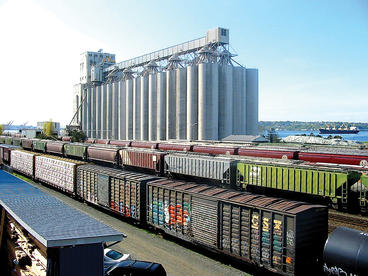
Dynamic and innovative industry clusters are critical for the success of a regional economy. As a critical mass, industry clusters promote efficiencies that individual businesses or industries cannot. But questions remain: Which industries are growing? Does Minnesota’s freight infrastructure meet industry needs? How do clusters affect transportation systems and local communities?
To fill this information need, TPEC researchers study Minnesota’s industry clusters and engage regional business and policy leaders. Recent work has focused on the medical industry cluster, with particular focus on impacts of the pandemic. The result is a valuable knowledge base to inform freight infrastructure planning and investment decisions.
Medical Device Industry Cluster in Greater Minnesota: Spatial Impacts and Illustrative Case Study
In a series of studies, University of Minnesota researchers have mapped and analyzed the state’s medical device industry cluster, exploring its economic impact and the vital role of transportation in its success. In their latest work, researchers analyzed the economic, community, and supply chain aspects of the medical device industry in Minnesota, with particular attention to its impact on Greater Minnesota.
The new research reveals that while there is a concentration of companies within the Twin Cities metro area, many companies in this cluster are highly dispersed throughout the state. Supply chain mapping demonstrates the importance of regional transportation networks for shipping within the cluster and for reaching national and international markets. And interviews with corporate leaders convey how a business strategy based on industry clusters can benefit individual firms—and their employees and communities.
The research is summarized in an online StoryMap containing the quantitative findings that illustrate the cluster’s statewide expanse. A case study takes a deeper look at one innovative Minnesota firm—Granite Partners—that is investing in the Minnesota medical device industry and other clusters that are principally located in Greater Minnesota.
The findings of this research offer valuable insights for policymakers on how this robust industry drives economic development and competitiveness across Minnesota. They also underscore the importance of infrastructure investment in supporting the cluster’s continued growth.
Minnesota Supply Chain Forum: Transportation and Consumer Considerations in the Age of COVID-19
Transportation and supply chains have become a central focus for Minnesota legislators and policymakers. In a January 2022 forum, CTS and the TPEC Program convened experts to examine the businesses and supply chains that are key to Minnesota’s economy, with attention to the ongoing impacts of the COVID-19 pandemic. The forum was organized in response to interest from Representative Frank Hornstein, chair of the Minnesota House Transportation Finance and Policy Committee.
Forum participants included representatives from both the private and public sectors as well as the research community. Topics included network resiliency, port back-ups, the trucker shortage, and pending federal legislation. Read coverage of the forum.
Sustaining Minnesota’s Medical Device Industry Cluster: A Vital Role for Multimodal Transportation
Minneapolis–Saint Paul International Airport (MSP) plays a vital role for the medical device industry supply chain—which means surface transportation linkages to MSP are also crucial.
Using geographic information systems analysis, TPEC researchers identified medical device industry “hot spots” in the Twin Cities metro and conducted a case study of one of them: the City of Plymouth. They then overlaid hot spots onto maps of major freight corridors and assessed trucking times to MSP for key companies.
The research set the stage for a TPEC Program forum in October 2021. The forum convened state and national experts to discuss the implications for Minnesota’s infrastructure and economic competitiveness, with a focus on the state’s medical device and health care industries.
Presenters discussed air cargo needs at MSP; Minnesota’s “brand” as a global authority in medicine; the state’s freight plan, including infrastructure for electric trucks; and the “bioinnovation” economy—the medical device industry combined with the food and agriculture industries.
A TPEC report incorporates highlights from the forum and recent TPEC research. The report also includes recommendations to address challenges and opportunities stemming from the pandemic.
Completed research
- Assessment of Spatial Location and Air Transport Patterns of Minnesota’s Medical Device Industry Cluster. Journal of Strategic Innovation and Sustainability, 2021.
- Spatial Location and Air Transport Connections: The Case of Minnesota’s Medical Device Industry Cluster. Proceedings of the 54th Hawaii International Conference on System Sciences, 2021.
- Evolving Supply Chains and Local Freight Flows: A Geographic Information System Analysis of Minnesota Cereal Grain Movement. Transportation Research Record, 2018.
- Amber Roads of Grain (2017)
- Obtaining manufacturers’ perspectives in making regional transportation decisions, Community Development Journal, Feb. 2017
- Transportation Planning to Support Economic Development: An Exploratory Study of Competitive Industry Clusters and Transportation in Minnesota, January 2015, Report no. MnDOT 2015-02